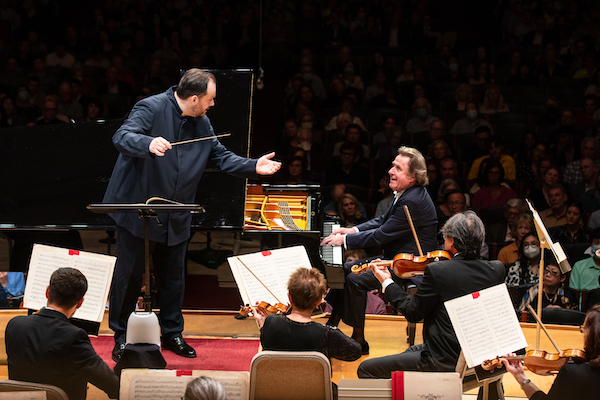Nelsons, Boston Symphony open season with light program, mixed results

Music director Andris Nelsons led the Boston Symphony Orchestra’s season-opening concert Thursday night at Symphony Hall. Photo: Robert Torres
This week’s unseasonably warm temperatures notwithstanding, autumn has arrived in New England and, with it, the Boston Symphony Orchestra. The ensemble opened its 143rd season Thursday night at Symphony Hall with Andris Nelsons conducting a lightish program of music by Beethoven, Mozart, Arturs Maskats, and Richard Strauss.
The event marked the start of Nelsons’ tenth season as the BSO’s music director, a fact the conductor noted in his well-meaning, if meandering, pre-concert remarks. In that decade, he’s proven to be an inspired purveyor of new music as last night’s traversal of Maskats’ Tango reminded.
True, the 2002 piece is eleven minutes of fluff. But it’s well-written and brilliantly scored fluff.
The evening’s rendition was, predictably, superb, the BSO reveling in the Latvian composer’s winning play of color and rhythm. Balances, even in dense moments, were assured. Julien Labro’s wheezing bandoneon lent the proceedings a touch of sultry heat.
When it comes to the canon, Nelsons is historically less predictable. So it went last night. One wished, for instance, that the close attention to details of dynamics and texture lavished on the Tango had been equally applied to Beethoven’s Consecration of the House Overture.
As it was, Thursday’s reading of the score recalled the last time Nelsons and Co. offered the work in September 2021: the orchestral tone was, again, too often monochrome, with brass tattoos and background figures vying against (and sometimes covering) the melodic line.
The opening Maestoso’s vigorous bassoon runs, for instance, were buried underneath the trumpet fanfares they embellish. At the same time, the Allegro con brio section moved energetically, the quiet contrapuntal episodes spoke clearly, and the closing bars evinced a winning brashness.
Further mismatches of character and musical purpose ensued in the evening’s account of Mozart’s Piano Concerto No. 23.

Rudolf Buchbinder performed Mozart’s Piano Concerto No. 23 with Nelsons and the BSO Thursday night. Photo: Robert Torres
Pianist Rudolf Buchbinder is an eminent interpreter of this fare but, on Thursday, he and Nelsons often seemed to be working at cross-purposes.
For his part, Buchbinder treated his Steinway like a fortepiano, incisively attacking his part while also pushing the line here and there. Unfortunately, excessive pedaling muddied some of the outer-movement runs and rigid orchestral playing emphasized a spirit of disconnect.
Nelsons drew an accompaniment from the BSO that was secure, warm, and generally fresh. But it boasted a large string complement that occasionally sounded rhythmically stiff. Accordingly, there was little of the conversational give-and-take between keyboard and ensemble that, in other contexts, can make this music (especially in the first and third movements) come so thrillingly to life.
Only during the Adagio were Buchbinder and the BSO regularly operating on the same plane. In this movement, where Mozart is at his most sublimely melancholic, Thursday’s reading was beautifully sung, marked by a big dynamic range and fired by a palpable sense of inner purpose.
The former quality was also invigoratingly evident in the orchestra’s performance of the Suite from Der Rosenkavalier. True, Thursday’s interpretation of this Strauss favorite showcased some of Nelsons’ more frustrating tendencies: trumpets were too loud at the end, transitions felt mannered, the first waltz sequence was obsessively micromanaged (more fundamentally, its overall tempo was too slow), and the Presentation of the Rose music was spacious to the point of stasis.
At the same time, the Nelsons-led BSO has rarely sounded better technically or sonically than they did in this music last night. The introduction was plush and gorgeous. The Suite’s various solos were all on point. Textures in the closing trio (“Hab mir’s gelobt”) were lucid. Best of all, the climactic horn licks in the last waltz were so burnished and creamy they might have made the brass section of the Vienna Philharmonic blush.
The program will be repeated 1:30 p.m. Friday at Symphony Hall. bso.org
Posted in Performances